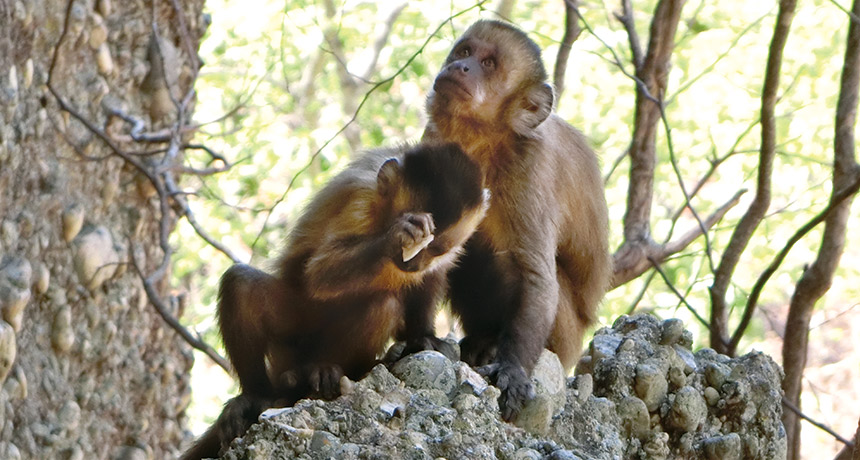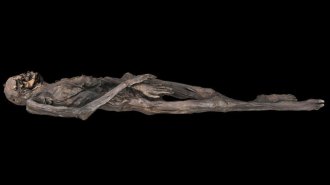Wild monkeys throw curve at stone-tool making’s origins
Unlike early hominids, capuchins don’t use sharp-edged rocks to dig or cut

IN FOR A POUND A capuchin monkey in Brazil uses a handheld stone to hammer an embedded rock. Researchers say these wild primates unintentionally detach pieces of rock shaped like basic hominid stone tools, raising questions about how toolmaking evolved.
Michael Haslam/Primate Archaeology Group
A group of South American monkeys has rocked archaeologists’ assumptions about the origins of stone-tool making.
Wild bearded capuchin monkeys in Brazil use handheld stones to whack rocks poking out of cliffs and outcrops. The animals unintentionally break off sharp-edged stones that resemble stone tools made by ancient members of the human evolutionary family, say archaeologist Tomos Proffitt of the University of Oxford and his colleagues. It’s the first observation of this hominid-like rock-fracturing ability in a nonhuman primate.
The new finding indicates that early hominids needed no special mental ability, no fully opposable thumbs and not even any idea of what they were doing to get started as toolmakers, the researchers report October 19 in Nature. All it may have taken was a penchant for skillfully pounding rocks, as displayed by capuchins when cracking open nuts (SN Online: 4/30/15).
Archaeologists have traditionally thought that ancient stone tools appeared as hominid brains enlarged and hand grips became more humanlike.
“Without the intention of making a stone tool, and with the right rock types, capuchins produce objects that are shaped like stone tools,” says University of Oxford primatologist and archaeologist Susana Carvalho, who did not participate in the new study. She suspects the earliest known stone tools were made either by relatively small-brained hominids or, perhaps in some cases, nonhuman primates. “This is not a wild idea anymore.”
The oldest known hominid stone artifacts — a set of pounding rocks and sharp-edged stone flakes — date to 3.3 million years ago in East Africa (SN: 6/13/15, p. 6). Those tools display more elaborate modifications than observed on sharp-edged capuchin creations, Proffitt says. But researchers suspect simpler hominid tools go back 4 million years or more. Those implements might have looked more like what the South American monkeys make, he speculates.
Story continues below video
SMASHING SUCCESS Investigators videotaped this capuchin monkey during a rock-pounding episode. The animal occasionally licks an embedded rock where it has been pounded. Researchers say that capuchin rock smashers inadvertently produce sharpened pieces of rock resembling ancient hominids’ stone tools. Michael Haslam/Primate Archaeology Group |
Three capuchins tracked during an episode of rock pounding did not use fractured pieces of sharp stone to cut, scrape or dig up anything. Observations of nearly 100 rounds of rock pounding show that the monkeys sometimes recycled stone flakes as rock-pounding tools. They also often licked or sniffed powdered stone produced as they pounded rocks. Perhaps capuchins want to ingest the trace nutrient silicon, which assists in bone growth, or find lichens for some medicinal purpose, Proffitt suggests.
His team studied 60 stone fragments left behind by capuchins after rock-pounding episodes and another 51 capuchin-modified stones found in two excavations where rock pounding occurred. These artifacts included complete and broken pounding stones, stone flakes and stones that had been struck by rock-wielding monkeys.
Capuchin stone flakes are smaller and contain fewer fractured areas than ancient hominid tools, such as the 3.3-million-year-old East African finds, says archaeologist David Braun of George Washington University in Washington, D.C. But sharp-edged stones produced by the monkeys display “remarkable similarity” to artifacts from a nearby Brazilian site that some researchers think were made by humans more than 20,000 years ago (SN: 10/18/14, p. 14), Braun says. Researchers now must determine whether stone artifacts found at several South American sites dating to more than 14,000 years ago were made by humans or monkeys, he suggests.
Capuchin rock smashers’ inadvertently sharpened debris also raises questions about how hominids started making tools in the first place. Techniques for using one stone to pound away pieces of another stone, creating a rock with smooth faces bordered by razor-sharp edges, “could have been invented independently in different hominid species through [stone-pounding] behaviors we have yet to identify,” Proffitt says.
Those initial tools may have resembled capuchins’ accidentally sharpened stones or even rocks used by chimpanzees to crack nuts, says archaeologist Sonia Harmand of Stony Brook University in New York. But only hominids, and especially humans, went on to make more sophisticated stone tools and, later, everything from smart phones to space stations, says Harmand, who led the team that discovered the 3.3-million-year-old hominid tools.







